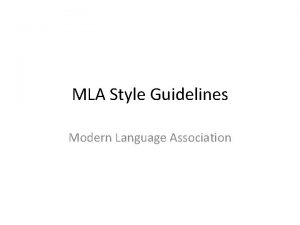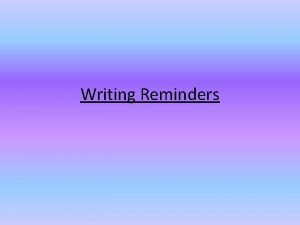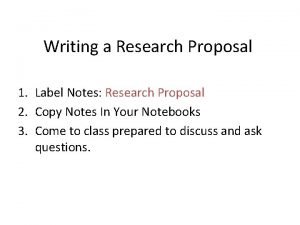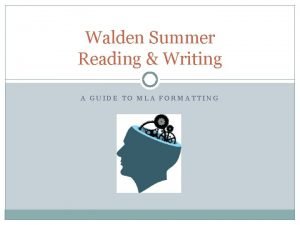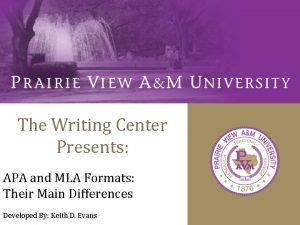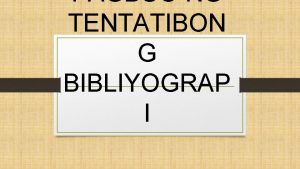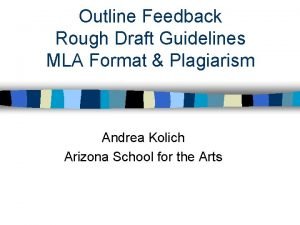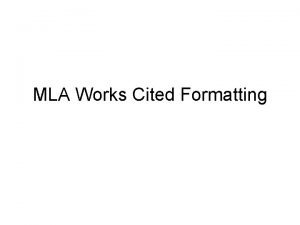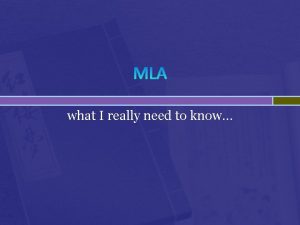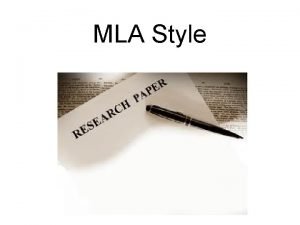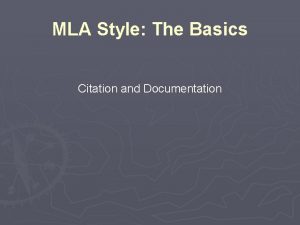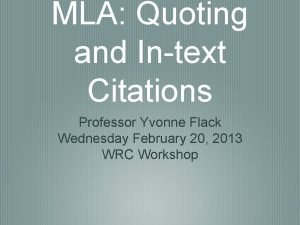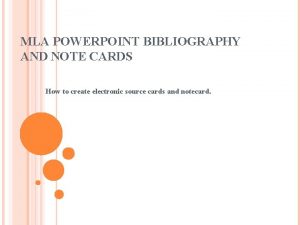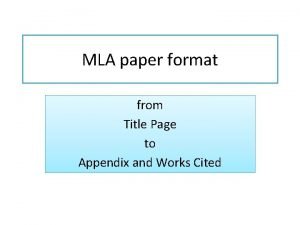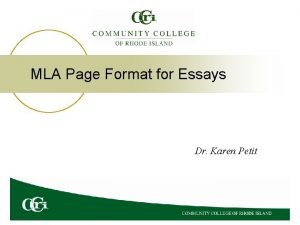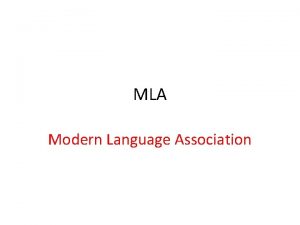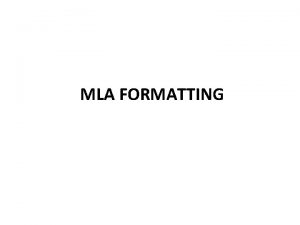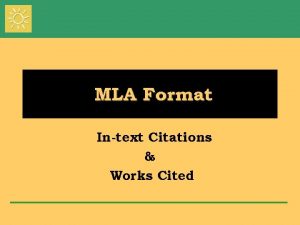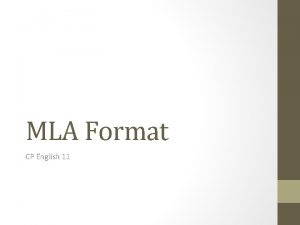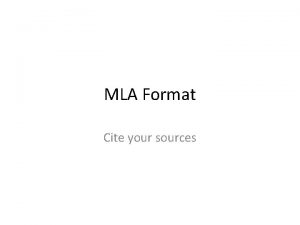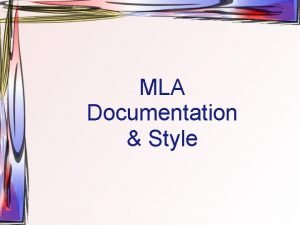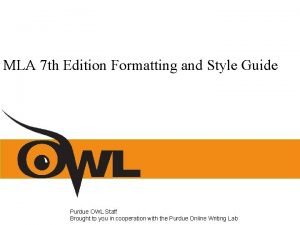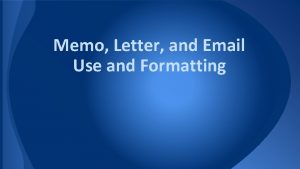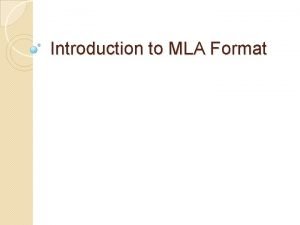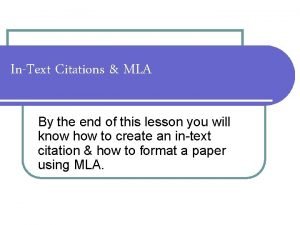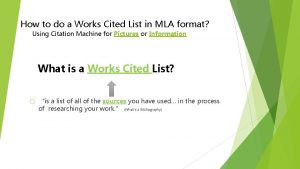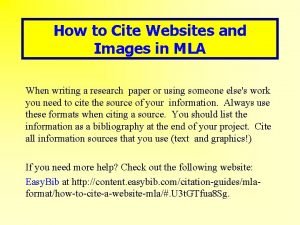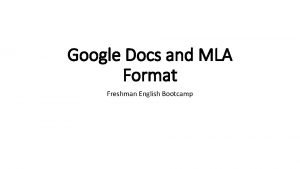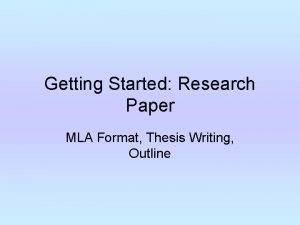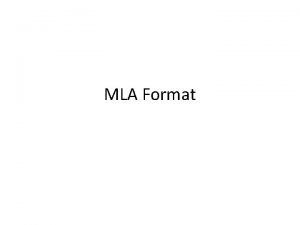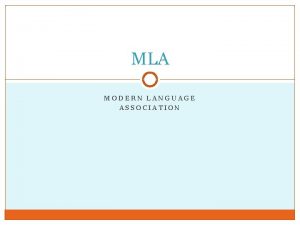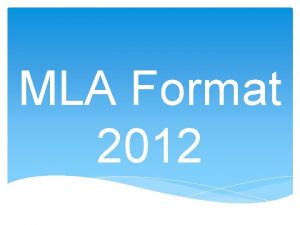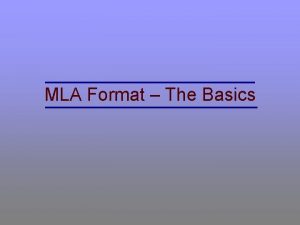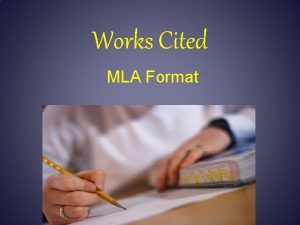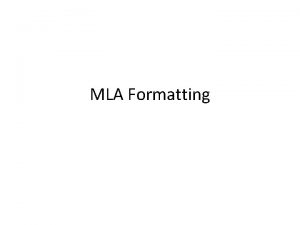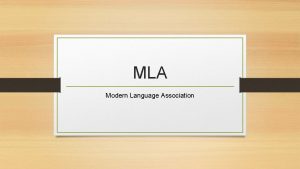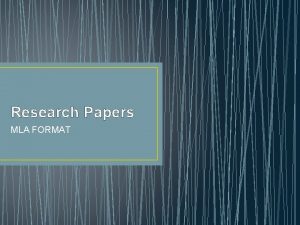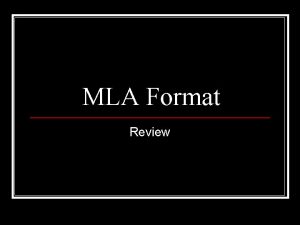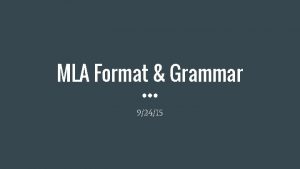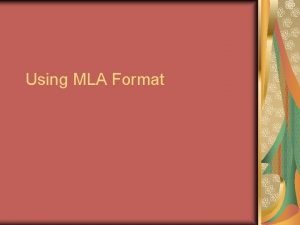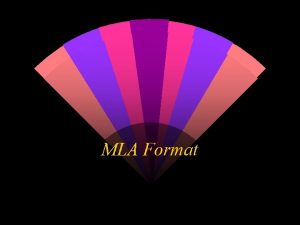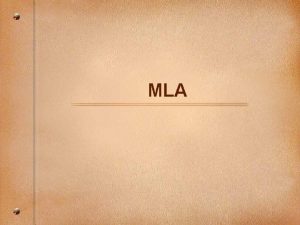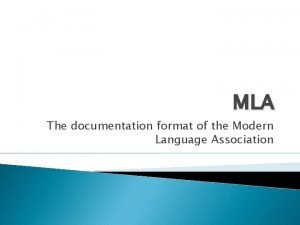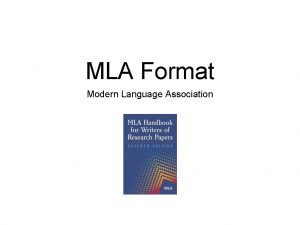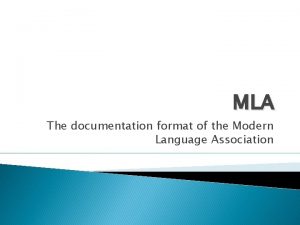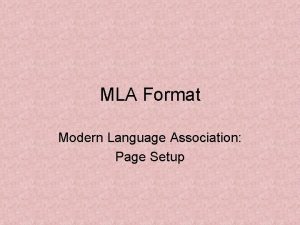MLA Format What is MLA MLA Modern Language
































- Slides: 32

MLA Format

What is MLA? MLA (Modern Language Association) style formatting is often used in various Humanities disciplines

Formatting the 1 st Page Ø No title page Ø Double space everything ØIn the upper left corner of the 1 st page, list your name, your instructor's name, the course, and date ØCenter the paper title (use standard caps but no underlining, italics, quote, or bold) ØCreate a header in the upper right corner at half inch from the top and one inch from the right of the page (include your last name and page number)

Sample 1 st Page

Plagiarism � Remember that your paper MUST contain intext citations. � Papers without citations will result in a 0. This is what we call plagiarism. � Any information must be cited unless it is common knowledge. ( Christmas is December 25 th. )

� Even if you paraphrase information, you MUST credit the source with an in-text citation. � Yes, you do need in-text citations and a works cited page.

In-Text Citations: the Basics Ø MLA uses parenthetical citations Ø Parenthetical citations depend on the medium (e. g. Print, Web, DVD) Ø Parenthetical citations also depend on the source’s entry on the Works Cited page Ø Signal word in the text is the first thing in the corresponding entry on the Works Cited page

Author-Page Style In-text Example: Wordsworth stated that Romantic poetry was marked by a "spontaneous overflow of powerful feelings" (263). Romantic poetry is characterized by the "spontaneous overflow of powerful feelings" (Wordsworth 263). Wordsworth extensively explored the role of emotion in the creative process (263). Corresponding Works Cited Entry: Wordsworth, William. Lyrical Ballads. Oxford U. P. , 1967.

Print Source with Author In-text Example: Human beings have been described by Kenneth Burke as "symbol-using animals" (3). Human beings have been described as "symbol-using animals" (Burke 3).

Print Source with Author Corresponding Works Cited Entry: Burke, Kenneth. Language as Symbolic Action: Essays on Life, Literature, and Method. U of California P, 1966.

With Unknown Author In-text Example: We see so many global warming hotspots in North America likely because this region has “more readily accessible climatic data and more comprehensive programs to monitor and study environmental change. . . ” (“Impact of Global Warming” 6).

With Unknown Author Corresponding Works Cited Entry: “The Impact of Global Warming in North America. ” GLOBAL WARMING: Early Signs. 1999. Web. 23 Mar. 2009.

Website � Author’s � INCLUDE name � Title of article or page � Title of the website � Name of the publisher � Date the page or site was published � The URL

� Author’s last name, first name. “Title of Article or Individual Page”. Title of the website, Name of the publisher, Date of publication, URL.

Works Cited entry White, Laura. “The Newest Fad in People Helping People: Little Free Pantries. ” Upworthy, Cloud tiger Media, 3 August 2016, www. upworthy. com/the-newestfad-in-people-helping-people (White 2).

Works Cited � 1. Your works cited page is a list of all references that were used in your paper. � 2. � 3. It should be on a separate sheet of paper. Label the page Works Cited (do not italicize the words Works Cited or put them in quotation marks) and center the words Works Cited at the top of the page.

� 4. Double space all citations, but do not skip spaces between entries. � 5. Indent the second and subsequent lines of citations by 0. 5 inches to create a hanging indent. � 6. Your works cited should be in alphabetical order.

Creating works cited using the 8 th edition � Core � 1. � 2. � 3. � 4. � 5. � 6. � 7. � 8. � 9. elements included: Author Title of source Title of container Other contribut 0 rs Version Number Publisher Publication date Location

� 1. Author- Writer of the material � 2. Title of source- Should follow author’s name � 3. Title of container- Larger units where the source is located. (Book, television series, website, etc. ) � 4. Other contributors- Editors, translators, etc. � 5. Version- Version or edition- King James Version

� 6. Number- If the source is a multiplevolume book or is part of a numbered sequence, a number must be included. � 7. Publisher- Who? � 8. Publication date- When? � 9. Location- Book= page numbers � Online source= URL 10. Other- Include dates of access,

Works Cited 1. Burke, Kenneth. Language as a Symbolic Action : Essays on Life, Literature, and Method. U of California P, 1966. 2. White, Laura. “The Newest Fad in People Helping People: Little Free Pantries. ” Upworthy, Cloud tiger Media, 3 August 2016, www. upworthy. com/the-newest-fad-in-peoplehelping-people �

Helpful Websites � Easybib. com � Citationmachine. net � https: //owl. english. purdue. edu/owl/

� 1. The student is quoting from page 26 of the following source: � Hawley, Richard A. Thinking about Drugs and Society: Responding to an Epidemic. New York: Walker, 1988. Print. � a. Richard A. Hawley reports that although the ancient Chinese used marijuana for medical purposes, “there is no record of the Chinese using it as a pleasure producing drug” (26). � b. Richard A. Hawley reports that although the ancient Chinese used marijuana for medical purposes, “there is no record of the Chinese using it as a pleasure producing drug. ” (26)

a. Richard A. Hawley reports that although the ancient Chinese used marijuana for medical purposes, “there is no record of the Chinese using it as a pleasure producing drug” (26).

� 2. The student is summarizing information from page 63 of the following source: Henningfield, Jack E. , and Nancy Almand Ator. Barbiturates: Sleeping Potion or Intoxicant? New York: Chelsea, 1986. Print. � a. Drugs classified as Schedule I by the Drug Enforcement Administration are illegal, even for medical purposes, but they are allowed in authorized experiments (Henningfield 63). � b. Drugs classified as Schedule I by the Drug Enforcement Administration are illegal, even for medical purposes, but they are allowed in authorized experiments (Henningfield and Ator 63).

� b. Drugs classified as Schedule I by the Drug Enforcement Administration are illegal, even for medical purposes, but they are allowed in authorized experiments (Henningfield and Ator 63).

� 3. The student is citing a statistic that appeared in the following unsigned article: “Cross-Eyed and Painless. ” Economist 6 July 1991: 89. Print. � a. Nearly half of 1, 035 oncologists surveyed in 1991 said that if smokable marijuana were legal for cancer patients, they would prescribe it (Economist 89). � b. Nearly half of 1, 035 oncologists surveyed in 1991 said that if smokable marijuana were legal for cancer patients, they would prescribe it (“Cross-Eyed” 89).

� b. Nearly half of 1, 035 oncologists surveyed in 1991 said that if smokable marijuana were legal for cancer patients, they would prescribe it (“Cross-Eyed” 89).

� 4. The student is quoting from page 79 of the following source: Marshall, Eliot. Legalization: A Debate. New York: Chelsea, 1988. Print. � There are two works by Marshall in the list of works cited. � a. Marshall explains that marijuana can be dangerous for people with heart conditions because its use “can dramatically increase heart rate and blood pressure” (Legalization 79). � b. Marshall explains that marijuana can be dangerous for people with heart conditions because its use “can dramatically increase heart rate and blood pressure” (79).

� a. Marshall explains that marijuana can be dangerous for people with heart conditions because its use “can dramatically increase heart rate and blood pressure” (Legalization 79).

� 5. The student is quoting from page 67 of the following source: Marshall, Eliot. Legalization: A Debate. New York: Chelsea, 1988. Print. � There are two works by Marshall in the list of works cited. � a. The US Drug Enforcement Administration has allowed marijuana to be used in experiments with patients suffering from glaucoma. According to one expert, “Several studies since 1971 have shown that smoking marijuana causes the pressure within the eye to decrease and to remain at a lowered level for about five hours” (Legalization 67). � b. The US Drug Enforcement Administration has allowed marijuana to be used in experiments with patients suffering from glaucoma. According to one expert, “Several studies since 1971 have shown that smoking marijuana causes the pressure within the eye to decrease and to remain at a lowered level for about five hours” (Marshall, Legalization 67).

� b. The US Drug Enforcement Administration has allowed marijuana to be used in experiments with patients suffering from glaucoma. According to one expert, “Several studies since 1971 have shown that smoking marijuana causes the pressure within the eye to decrease and to remain at a lowered level for about five hours” (Marshall, Legalization 67).
 Language font style
Language font style Thesis statement format
Thesis statement format Purpose of research proposal
Purpose of research proposal Mla format handwritten
Mla format handwritten Mla format specifications
Mla format specifications Apa headings example
Apa headings example Ano ang dapat tandaan sa pagsulat ng bibliyograpiya?
Ano ang dapat tandaan sa pagsulat ng bibliyograpiya? Mla rough draft format example
Mla rough draft format example Owl mla work cited
Owl mla work cited Mla heading
Mla heading Intext citation
Intext citation Mla title page
Mla title page How to cite part of a sentence
How to cite part of a sentence Mla source card
Mla source card Appendices example in research paper pdf
Appendices example in research paper pdf Mla format top left corner
Mla format top left corner Does mla prefers times new roman
Does mla prefers times new roman Paragraphs in mla format
Paragraphs in mla format Mla works cited page
Mla works cited page Whats works cited
Whats works cited Mla work cited page example
Mla work cited page example Great gatsby citation mla
Great gatsby citation mla What is mla format for citing sources
What is mla format for citing sources Formal header
Formal header Works cited page example
Works cited page example Memo format email
Memo format email Date on letter
Date on letter Parenthetical citation
Parenthetical citation Mla format heading
Mla format heading How to mla format a link
How to mla format a link How to cite an image from a website mla
How to cite an image from a website mla How to write in mla format on google docs
How to write in mla format on google docs Mla research paper outline example
Mla research paper outline example
